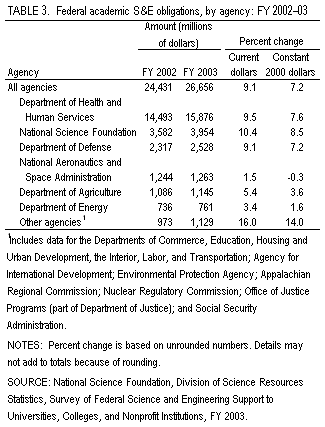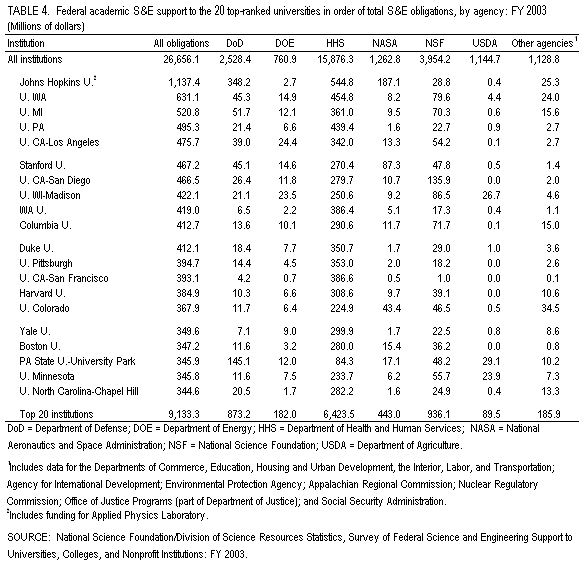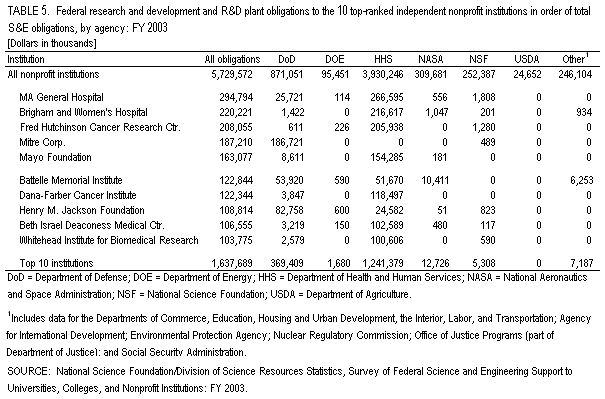| |
 | ||
|
|||
Federal Science And Engineering Obligations To Academic And Nonprofit Institutions Reached Record Highs In FY 2003
Statistics from the National Science Foundation (NSF) Survey of Federal Science and Engineering Support to Universities, Colleges, and Nonprofit Institutions show that federal agencies obligated a new high of $26.7 billion to higher education institutions for academic science and engineering (S&E) activities in FY 2003, an increase of $2.2 billion (9 percent in current dollars) over FY 2002 levels (table 1). This increase follows a 9 percent current-dollar increase (nearly 7 percent in constant dollars) in total federal academic S&E support between FY 2001 and FY 2002.
Table 1 Source Data: Excel fileCategories of Support
Federal academic S&E obligations are divided into six categories: research and development (R&D), which has accounted for 84–87 percent of total federal academic S&E obligations over the last decade (figure 1); R&D plant; facilities and equipment for S&E instruction; fellowships, traineeships, and training grants (FTTGs); general support for S&E; and other S&E activities.
Figure 1 Source Data: Excel fileFederal academic R&D support reached a new high of $22.8 billion in FY 2003, nearly an 8 percent current-dollar increase (6 percent in constant dollars) over the previous year. The Department of Health and Human Services (HHS) accounted for 63 percent ($14.3 billion) of all federal academic R&D obligations in FY 2003 (table 2) and 60 percent of the total R&D increase from FY 2002 to FY 2003.
Table 2 Source Data: Excel fileFederal support in FY 2003 for R&D plant grew by 141 percent, from $301 million in FY 2002 to an unprecedented level of $727 million. The National Institutes of Health (NIH) (within HHS) was directly responsible for 90 percent of the academic R&D plant spike. The one-time major investment in academic facilities from NIH (NIH stated that it would not be repeated in FY 2004) was highlighted by increases exceeding $100 million at both Boston University and the University of Texas Medical Branch at Galveston. Seven other universities reported increased facilities funding from NIH of at least $10 million each.
Two of the four remaining S&E categories were also at record funding levels in FY 2003.
- Federal obligations for FTTGs increased 1 percent to $950 million, with HHS and the Department of Education providing most of the increase.
- Obligations for other S&E activities[1] increased by 11 percent, to $1.7 billion, with NSF and the Department of Defense (DoD) supplying most of this increase.
- Funds for facilities and equipment for S&E instruction fell to $80 million, a 27 percent decrease, with the Department of Commerce reporting most of the decline.
- Funding for general support projects[2] totaled $429 million, a 1 percent decrease stemming almost entirely from decreased HHS support.
Agency Sources
The Department of Health and Human Services accounted for 60 percent of all federal FY 2003 academic S&E obligations. Three agencies, NSF (nearly 15 percent of academic S&E), DoD (over 9 percent of academic S&E), and HHS, when combined, provided 84 percent of total federal academic S&E funding (table 3). The National Aeronautics and Space Administration (NASA), the Department of Agriculture (USDA), and the Department of Energy (DOE) provided most of the remaining academic S&E total, 12 percent of academic S&E federal funding. Of these six agencies, only NASA decreased (by a fraction of 1 percent) its FY 2003 academic S&E levels in constant dollars.
Table 3 Source Data: Excel fileUniversity Shares
The Johns Hopkins University (including its Applied Physics Laboratory) continued to be the leading academic recipient of federal academic S&E support in FY 2003 (table 4). Together, HHS and DoD provided Johns Hopkins with almost four-fifths of its federal S&E funds. Nearly $6 of every $7 in the university's total federal S&E obligations ($1.14 billion) supported R&D programs, with most of the remainder allocated to other S&E activities.
Table 4 Source Data: Excel fileThe top 20 universities in terms of federal academic S&E obligations accounted for 34 percent of the federal academic S&E total in FY 2003. Nineteen of these 20 academic recipients were also ranked among the top 20 recipients in the previous year. Boston University (ranked 17th in FY 2003, jumping from 32nd in FY 2002) replaced Cornell University (ranked 21st in FY 2003, dropping from 18th the prior year). About $5 of every $6 of the $153 million dollar surge in academic S&E support to Boston University was attributable to the $128 million supplied by NIH for R&D plant programs in FY 2003.
Federal S&E Support to Nonprofit Institutions
The National Science Foundation collects statistics on federal obligations to independent nonprofit institutions for two of the six S&E categories—R&D and R&D plant. Such federal obligations increased by over 8 percent, to a new high of $5.7 billion, between FY 2002 and FY 2003 (table 5). Most of the increased funding was from HHS, primarily from NIH. Massachusetts General Hospital received the most federal R&D and R&D plant funds among nonprofits in FY 2003, with HHS providing most of its support. The 10 top-ranked nonprofit institutions in terms of these federal funds in FY 2003 received 29 percent of the total funding to all nonprofits. Seven of these 10 nonprofit recipients were hospitals or medical research institutes. Each of these leading 10 nonprofits in FY 2003 also ranked among the top 10 in the prior year. Of all nonprofit recipients that were not hospitals or medical research institutes, the Mitre Corporation received the largest amount ($187 million) of federal R&D and/or R&D plant obligations.[3]
Table 5 Source Data: Excel fileData Notes
The federal academic S&E obligations data to academic and nonprofit institutions presented in this InfoBrief were obtained from 18 agencies that participated in the FY 2003 Survey of Federal Science and Engineering Support to Universities, Colleges, and Nonprofit Institutions. The survey collects federal S&E support data by funding agency, institution, type of activity, type of institution, and geographic location. The full set of detailed statistical tables on the FY 2003 Survey of Federal Science and Engineering Support to Universities, Colleges, and Nonprofit Institutions will be available online at http://www.nsf.gov/statistics/.
NSF makes available computer-generated institutional profiles for individual doctorate-granting institutions and for schools with S&E departments that grant master's degrees. These profiles contain data from this survey and from NSF's other two academic S&E surveys: the Survey of Research and Development Expenditures at Universities and Colleges and the Survey of Graduate Students and Postdoctorates in Science and Engineering. Data from the three surveys are also available on the Web (http://www.nsf.gov/statistics/) and on NSF's WebCASPAR database system, a Web tool for retrieval and analysis of statistical data on academic S&E resources (http://webcaspar.nsf.gov).
For more information, contact:
Richard J. Bennof
Division of Science Resources Statistics
National Science Foundation
4201 Wilson Boulevard, Suite 965
Arlington, VA 22230
703-292-7783
rbennof@nsf.gov
Footnotes
[1] Academic S&E obligations that cannot be assigned elsewhere and activities in support of technical conferences, teacher institutes, and programs aimed at increasing precollege and undergraduate students' scientific knowledge.
[2] Funds used for scientific projects and support for activities within a specified discipline; explicit purpose is not specified.
[3] During editing of the FY 2003 Federal S&E Support database, NSF revised DoD's support to the nonprofit Mitre Corporation at $211,508,000 for FY 2001 (previously reported by DoD as 0). DoD subsequently reviewed and concurred with these estimates.





